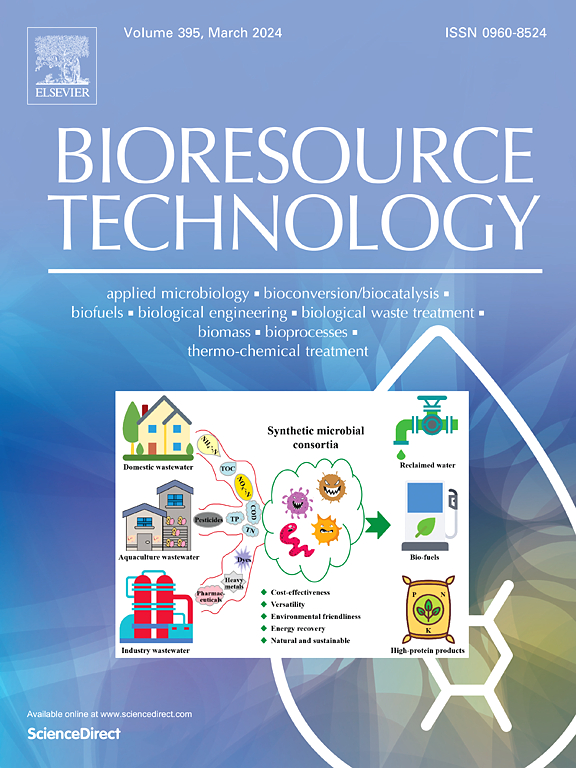High production of glycolic acid by Klebsiella pneumoniae: Engineering metabolic pathways and optimizing culture conditions
IF 9
1区 环境科学与生态学
Q1 AGRICULTURAL ENGINEERING
引用次数: 0
Abstract
Growing concerns regarding environmental pollution caused by non-biodegradable plastic waste have intensified the demand for sustainable biodegradable bioplastics. Glycolic acid (GA), the monomer of polyglycolic acid (PGA), is a key precursor in the production of biodegradable plastics. In this study, a systematic metabolic engineering strategy was employed to enhance GA production in Klebsiella pneumoniae via the xylose oxidation pathway. As a first step, wild-type K. pneumoniae CU (a non-GA-producing strain) was transformed with the pETM-XFEA plasmid harboring four genes involved in the xylose oxidation pathway, resulting in KPGA0, which produced 4.0 ± 0.3 g/L of GA. To further increase metabolic flux, the xylA gene was deleted in KPGA0, yielding the KPGA1 strain, which produced 5.3 ± 0.4 g/L of GA—a 1.32-fold increase. Due to the accumulation of acetic acid and ethylene glycol as major byproducts in KPGA1, genes responsible for their production were subsequently deleted to construct KPGA11. Under optimized culture conditions (pH, agitation speed, and aeration), KPGA11 achieved 15.8 ± 0.6 g/L of GA, a 2.98-fold increase compared to KPGA1. Furthermore, fed-batch cultivation of KPGA11 resulted in a GA titer of 70.1 ± 3.1 g/L, a productivity of 0.730 ± 0.033 g/L/h, and a conversion yield of 0.283 ± 0.003 g/g. To the best of our knowledge, this study is the first to demonstrate high-titer GA production through upregulation of the xylose oxidation pathway in K. pneumoniae, and also reports the highest GA production achieved to date in a microbial system utilizing a carbon source.
肺炎克雷伯菌乙醇酸高产:工程代谢途径和优化培养条件。
人们对不可生物降解塑料废物造成的环境污染日益关注,加大了对可持续生物降解生物塑料的需求。乙醇酸(GA)是聚乙醇酸(PGA)的单体,是生产生物降解塑料的关键前驱体。本研究采用系统代谢工程策略,通过木糖氧化途径提高肺炎克雷伯菌GA的产生。首先,利用含有木糖氧化途径相关基因的pETM-XFEA质粒转化野生型肺炎克氏菌CU(一种不产GA的菌株),得到KPGA0,产生4.0 ± 0.3 g/L GA。为了进一步增加代谢通量,在KPGA0中删除了xylA基因,得到KPGA1菌株,其GA-a产量增加了1.32倍,为5.3 ± 0.4 g/L。由于在KPGA1中积累了乙酸和乙二醇作为主要副产物,因此随后删除了负责其产生的基因以构建KPGA11。在优化的培养条件(pH、搅拌速度和曝气)下,KPGA11的GA含量为15.8 ± 0.6 g/L,比KPGA1提高了2.98倍。此外,馈料式种植KPGA11导致GA 效价70.1±3.1 g / L,生产力0.730 ±0.033 g / L / h,和一个转换收益0.283 ±0.003 g / g。据我们所知,这项研究首次证明了肺炎克雷伯菌通过上调木糖氧化途径产生高滴度的GA,并报道了迄今为止在利用碳源的微生物系统中实现的最高GA产量。
本文章由计算机程序翻译,如有差异,请以英文原文为准。
求助全文
约1分钟内获得全文
求助全文
来源期刊

Bioresource Technology
工程技术-能源与燃料
CiteScore
20.80
自引率
19.30%
发文量
2013
审稿时长
12 days
期刊介绍:
Bioresource Technology publishes original articles, review articles, case studies, and short communications covering the fundamentals, applications, and management of bioresource technology. The journal seeks to advance and disseminate knowledge across various areas related to biomass, biological waste treatment, bioenergy, biotransformations, bioresource systems analysis, and associated conversion or production technologies.
Topics include:
• Biofuels: liquid and gaseous biofuels production, modeling and economics
• Bioprocesses and bioproducts: biocatalysis and fermentations
• Biomass and feedstocks utilization: bioconversion of agro-industrial residues
• Environmental protection: biological waste treatment
• Thermochemical conversion of biomass: combustion, pyrolysis, gasification, catalysis.
 求助内容:
求助内容: 应助结果提醒方式:
应助结果提醒方式:


